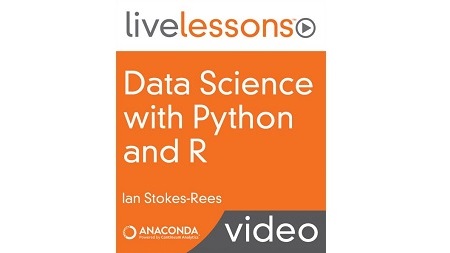
English | MP4 | AVC 1280×720 | AAC 44KHz 2ch | 9h 20m | 3.96 GB
Data Science with Python and R LiveLessons is tailored to beginner data scientists seeking to use Python or R for data science. This course includes fundamentals of data preparation, data analysis, data visualization, machine learning, and interactive data science applications. Students will learn how to build predictive models and how to create interactive visual applications for their line of business using the Anaconda platform. This course will introduce data scientists to using Python and R for building on an ecosystem of hundreds of high performance open source tools.
The companion Jupyter notebooks for these LiveLessons are available at anaconda.org/datasciencepythonr.
About Anaconda Powered by Continuum Analytics
Anaconda is the leading Open Data Science platform powered by Python, the fastest growing data science language with more than 11 million downloads to date. Continuum Analytics is the creator and driving force behind Anaconda, empowering leading businesses across industries worldwide with tools to identify patterns in data, uncover key insights and transform basic data into a goldmine of intelligence to solve the world’s most challenging problems. Anaconda puts superpowers into the hands of people who are changing the world. Learn more at continuum.io.
What You Will Learn
- Use Anaconda and Jupyter notebooks
- Understand Open Data Science concepts, roles, and workflows
- Wrangle data with Pandas
- Understand Anaconda Enterprise and collaboration workflows
- Create interactive visualizations with Bokeh
- Use Conda package management
- Use R for data processing and visualization
- Build statistical and predictive models
- Use Excel and Python with Anaconda Fusion
- Understand and use Mosaic for databases with distributed data
- Understand distributed and parallel computing with Dask
Table of Contents
01 Data Science with Python and R – Introduction
02 Learning objectives
03 1.1 Use Anaconda Repository for data science artifacts
04 1.2 Use Anaconda Navigator to open and run Jupyter Notebooks
05 1.3 Perform fundamental Jupyter operations
06 1.4 Ingest, analyze and clean data with Pandas
07 1.5 Visualize data with Bokeh
08 1.6 Create machine learning and predictive modeling with Scikit-Learn
09 Learning objectives
10 2.1 Understand the concept of Open Data Science
11 2.2 Identify the different personas on an Open Data Science team
12 2.3 Understand Open Data Science workflows
13 Learning objectives
14 3.1 Load, view and plot Pandas DataFrames
15 3.2 Modify content and create new columns
16 3.3 Use boolean masks for data selection
17 3.4 Read data from disk
18 3.5 Group data
19 3.6 Connect to a database
20 3.7 Work with time series data
21 3.8 Read and write Excel files
22 3.9 Publish notebooks to Anaconda Cloud
23 Learning objectives
24 4.1 Describe the Anaconda Distribution
25 4.2 Identify what Conda is used for
26 4.3 Relate Anaconda Enterprise components
27 4.4 Identify core technology components
28 4.5 Describe typical data science workflows
29 4.6 Create projects in Anaconda enterprise with a team
30 Learning objectives
31 5.1 Describe Bokeh
32 5.2 Plot Pandas DataFrames with bokeh.charts
33 5.3 Manage plot construction with bokeh.plotting
34 5.4 Use widgets and plot linking for interactivity
35 5.5 Create web plots
36 5.6 Create data apps using Bokeh Server
37 Learning objectives
38 6.1 Install packages from Navigator
39 6.2 Add channels from Navigator
40 6.3 Upgrade, downgrade and remove packages from Navigator
41 6.4 Create a new environment from Navigator
42 6.5 Select Conda environments and Jupyter kernels
43 6.6 Use Conda from the command line
44 6.7 Understand the difference between pip and conda
45 6.8 Keep pip and conda up to date
46 6.9 Export, save, and share Conda environments
47 6.10 Find packages on Anaconda Cloud and from Conda-Forge
48 Learning objectives
49 7.1 Configure an R analytics environment
50 7.2 Access and process data with dplyr and tidyr
51 7.3 Create visualizations with ggplot
52 7.4 Use linear models for predictive analytics
53 7.5 Create interactive visualizations with rBokeh and Shiny
54 7.6 Bridge between R and Python with rpy2
55 Learning objectives
56 8.1 Use Scikit-Learn to create a predictive model
57 8.2 Generate predictions with a model
58 8.3 Score a model
59 8.4 Visualize model performance
60 Learning objectives
61 9.1 Understand which problems Fusion solves
62 9.2 Install and start Fusion
63 9.3 Connect spreadsheets to codesheets
64 Learning objectives
65 10.1 Understand which problems Mosaic solves
66 10.2 Install and start Mosaic
67 10.3 Use Mosaic to register datasets and create data views
68 Learning objectives
69 11.1 Describe Dask in relation to Pandas
70 11.2 Profile the creation of Dask dataframes
71 11.3 Analyze and plot Dask data
72 Data Science with Python and R – Summary
Resolve the captcha to access the links!